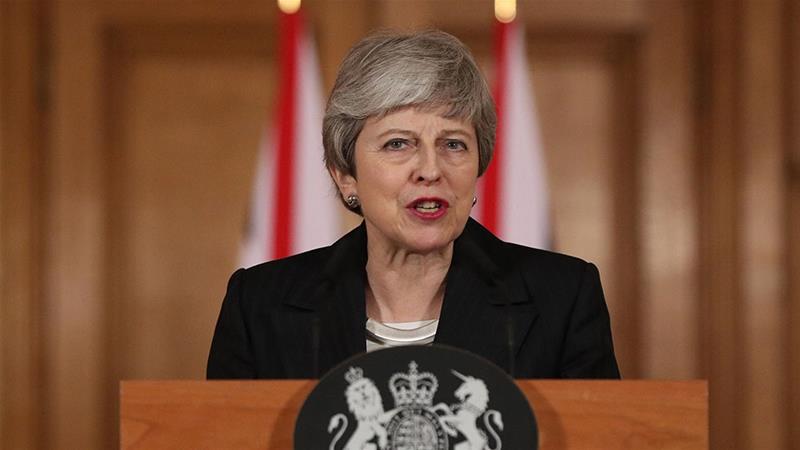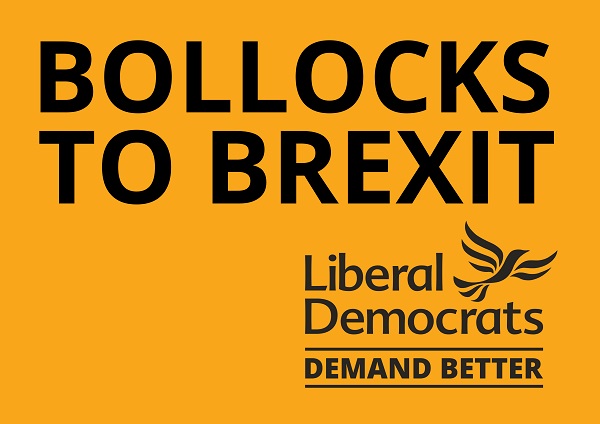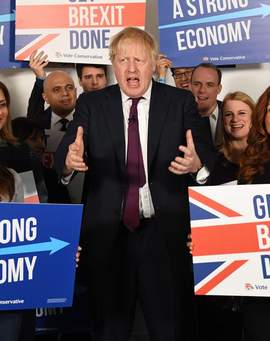|
BREXIT
2 On the 18th April 2017, Theresa May called a General Election. It was held on Thursday 8th June 2017. This was an utterly unnecessary election as the Tories had a sufficient, indeed, comfortable majority to govern. However, polls had suggested that the Tories were ahead by as much as 25% and May wanted a bigger majority in Parliament to push through her awful exit agreement for leaving the EU. It was a disaster. Far from gaining seats the Tories lost them. Theresa May had run a shambolic, lacklustre and robotic campaign, and she paid the price for it at the polls.
British
Prime Minister - Theresa May MP The
Tories lost 13 seats and lost their majority. They retained 317 seats,
but 326 are required for an absolute majority. The Labour Party had
gained 30 seats, giving them 232 seats in total. The only way the Tories
could continue to govern in any way, was by hastily arranging a
‘supply and confidence’ agreement, with the small Democratic
Unionist Party from Northern Ireland, who held ten seats. It was still a
wafer thin margin. The detailed background to the 2017 General Election
can be found here https://en.wikipedia.org/wiki/2017_United_Kingdom_general_election From then on, things went from bad to worse. The Tory Party had within its ranks at least twenty Remain MP’s, including senior party members within the cabinet. That was never going to be a recipe for getting Brexit legislation through the House. Eventually she came up with a formula upon which the UK could leave the EU, a formula that had been agreed with the EU and served their best interests. Some said it had actually been written by the EU, so disadvantageous was it for this country. This formula resulted in the November 2018 withdrawal agreement, but the UK parliament voted against ratifying it three times, with each party having their own reasons for doing so. It was never going to go through, as the Tory Party had a strong EU fifth column within its ranks, who were determined that the UK would remain within the EU, regardless of the expressed democratic will of the people, and they sided with the Labour Party and Liberal Democrats, infamous for the ‘Bollocks to Brexit’ campaign.
In
March 2019, the UK parliament voted for Theresa May to ask the EU to
delay Brexit until April, and then later, October. It was a humiliating
defeat for Theresa May and prolonged the uncertainty and chaos within
the country, not to mention the social tensions between the Leave and
Remain camps within the general public. Having failed to get her
agreement approved, May resigned as Prime Minister in July and was
succeeded by Boris Johnson. Nobody was sad to see the back of Theresa
May, a Leave supporter and no fan of Brexit herself. Radical change was
called for, Leavers demanded it, and Boris, a unique and controversial
political animal, was that change. Cometh the hour, cometh the man. Boris sought to replace parts of the discredited May agreement and vowed to leave the EU by the new deadline. On 17th October 2019, the UK government and EU agreed a revised withdrawal agreement, with new arrangements for Northern Ireland. Parliament approved the agreement for further scrutiny, but rejected passing it into law before the 31 October deadline, and forced the government (through the 'Benn Act') to ask for a third Brexit delay.
British
Prime Minister - Boris Johnson MP Boris,
frustrated by the sea anchor that Parliament had become, and recognising
he needed a decisive Tory majority in Parliament, called an early
general election, which was held on 12th December 2019. The British
people outraged by the Remain Establishment, Judiciary and the disloyal
cabal of old school Tory MP’s, demanded revolutionary change. Part of
that change, prior to the General Election, was the withdrawal of the
whip from Remain Tory MP’s who had been sabotaging the efforts of
Boris since his election as party leader. They would no longer be Tory
MP’s. There was serious political blood on the carpet as the
revolution with the Tory Party unfolded. The
Conservatives, in a stunning victory where they took many northern
seats, some of which had never been Tory before, won a very large
majority of 80 seats, with Boris Johnson declaring that the UK would
leave the EU in early 2020. The Tories could have won more seats without
doubt, if the Brexit Party had not split the Brexit vote in certain
constituencies. The withdrawal agreement was ratified by the UK on 23rd
January, by the EU on the 30th January, and it entered into force on
31st January 2020. The UK had officially left the EU and entered into a
12 month transition period. On 1st February, Boris hit the
ground running and has been bullish and decisive. No more appeasement
and kow-towing to Brussels. Britain is back and ready for the future. At
least it was, until the hammer blow of the COVID 19 pandemic hit the UK.
The first cases were identified in late January 2020 and transmission
within the UK was confirmed in late February. There was a rapid increase
in cases in March. On the 23rd March, the UK went into
lockdown and the economy ran into the buffers, but that is another
story. Brexit continues and the government stated there would be no
extension to the point when the UK fully disengages with the EU on 31st
December 2020, trade deal or no trade deal. ©Copyright - James of Glencarr |



